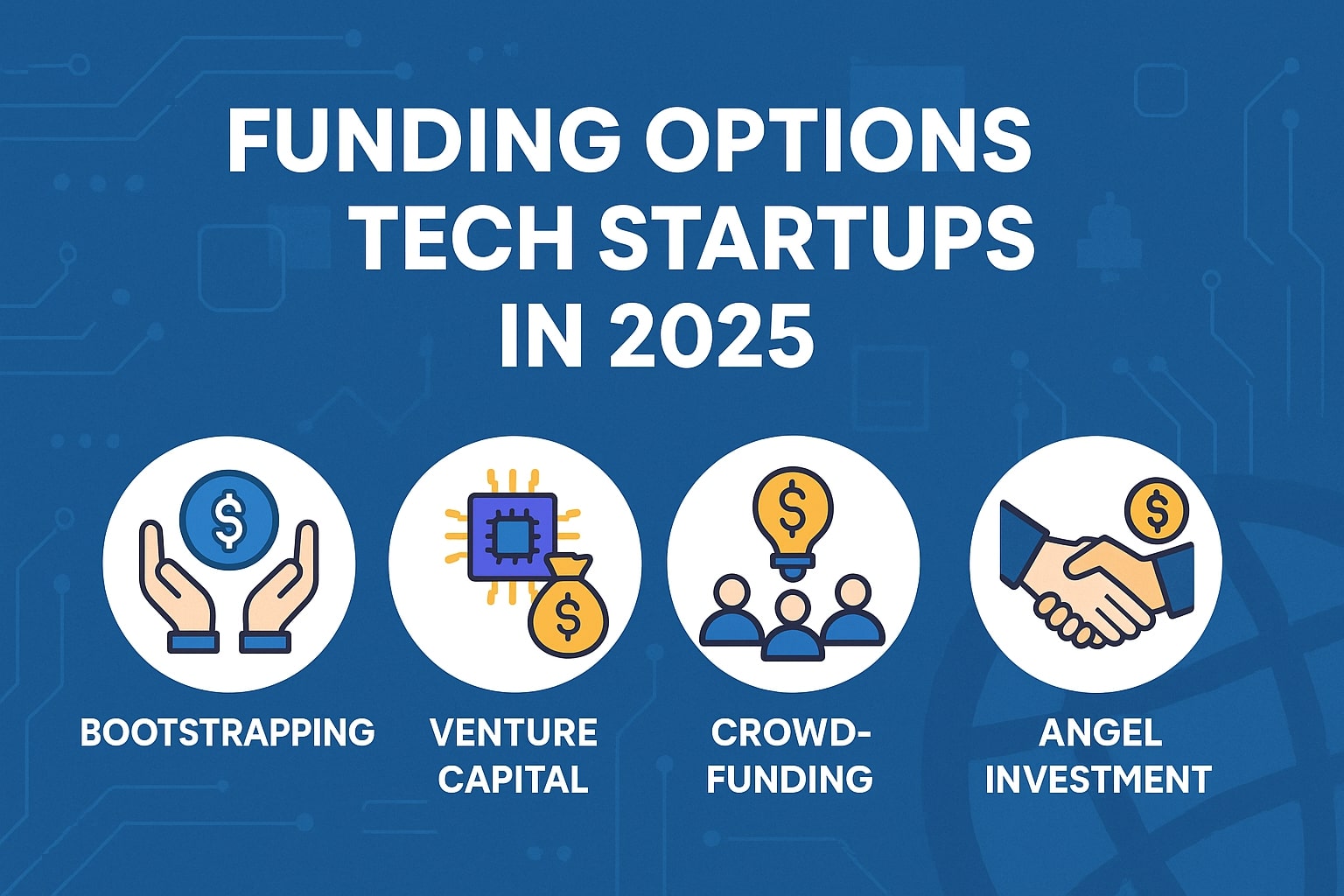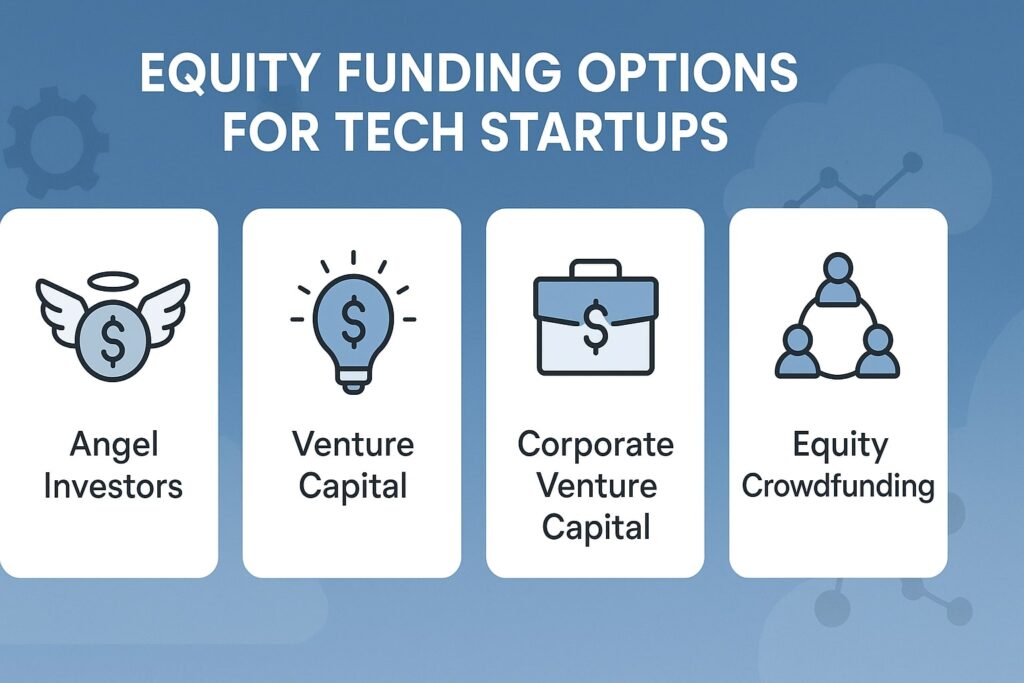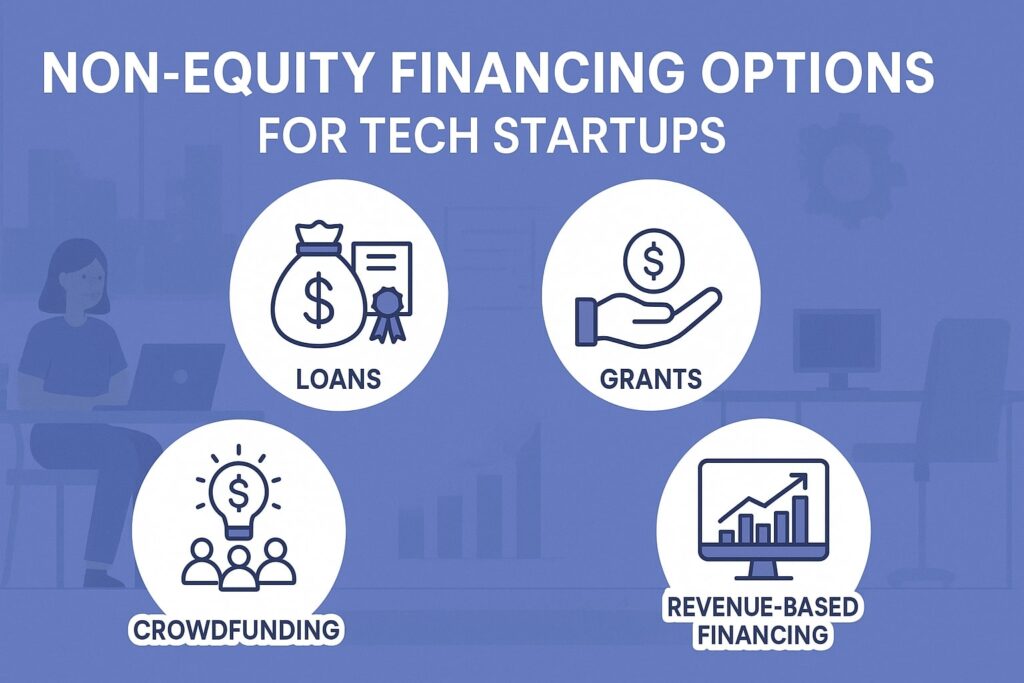
Funding Options for Tech Startups in 2025
The funding options for tech startups in 2025 are diverse, reflecting both traditional and emerging financing models. In the United States, entrepreneurs must navigate a mix of equity-based and non-equity funding sources to fuel growth.
Equity financing (selling ownership stakes) is common for high-growth ventures, while non-dilutive financing (debt, grants, crowdfunding, etc.) can preserve control. The right mix depends on a startup’s stage, capital needs, and business model.
In recent years, the U.S. tech sector has seen robust investment: North America attracted over $40.5 billion in VC funding in 2024, with artificial intelligence and clean technology leading the way.
However, overall venture funding has cooled compared to the frenzy of the early 2020s. As a result, many startups are supplementing venture capital with alternative sources like grants, loans, and revenue-based financing to extend their runway.
There are two broad categories of startup financing: equity financing and non-equity financing. Equity financing involves selling shares of the company in exchange for capital, whereas non-equity (debt or grant) financing provides funds without giving up ownership.
Understanding the differences is key. For example, venture capital and angel investors demand equity (and often board seats) in return for funding, whereas options like grants, loans, and crowdfunding typically do not. The table below summarizes major funding sources:
| Funding Option | Equity or Debt | Typical Stage | Key Benefits | Key Considerations |
|---|---|---|---|---|
| Venture Capital (VC) | Equity (dilutive) | Growth (Series A+) | Large capital, industry connections | High growth expectations, loss of control |
| Angel Investors | Equity (dilutive) | Early seed | Mentorship and networking, faster decisions | Limited funding amounts, equity dilution |
| Equity Crowdfunding | Equity (dilutive) | Seed stage | Broad investor pool, marketing buzz | Smaller raises ($100Ks), regulatory limits |
| Government Grants | Non-Equity (grants) | Early R&D / Seed | No repayment or dilution | Highly competitive, narrow eligibility |
| SBA / Bank Loans | Debt | Seed to Growth | Retain full ownership if repaid | Requires repayment & collateral, higher risk if unpaid |
| Revenue-Based Financing | Non-Equity (debt) | Early revenue stage | No equity loss, repaid via revenue share | Can be costly; payments fluctuate with sales |
| Crowdfunding (Rewards) | Non-Equity (rewards) | Pre-launch / Early | Validates product demand, pre-sales capital | Must fulfill product/perks; unpredictable outcome |
| Bootstrapping | Non-Equity (self) | Any (early) | Full control, no obligations | Limited capital, slower growth |
Equity Funding Options for Tech Startups

Venture Capital (VC) firms are professional investment groups that pool large sums from institutional investors or high-net-worth individuals. They target fast-growing tech startups and typically enter in Series A, B, or later rounds.
VC funding can range from a few million to tens of millions of dollars, enabling rapid scaling. However, VCs demand equity and often board seats. This dilutive capital usually requires demonstrating a scalable business model and high growth potential.
In practice, VCs in 2024 have focused heavily on sectors like artificial intelligence and cleantech. In North America, for example, AI startups dominated funding rounds, reflecting investor confidence in these fields. Entrepreneurs should prepare a strong pitch and business plan to attract VC interest.
Angel Investors are wealthy individuals or groups who invest personal funds in very early-stage startups (often Seed or pre-Seed stage).
Angel checks are typically smaller than VC rounds (often in the tens to hundreds of thousands of dollars per investor) and are exchanged for equity. In addition to capital, angels often provide valuable advice and industry connections.
The Angel Capital Association reports that U.S. angel groups saw a 33% drop in funding in 2023, underscoring the competitive market. Nevertheless, angels remain a crucial source for Seed rounds.
Founders should network in angel communities or use platforms (e.g. AngelList) to find aligned investors. Pitching to angels often emphasizes team expertise and product vision.
Equity Crowdfunding (Regulation Crowdfunding under U.S. SEC rules) allows startups to raise funds online from many investors. Under Reg CF, a company can raise up to $5 million per year from both accredited and non-accredited investors.
Equity crowdfunding combines elements of VC and public investing: backers receive company equity or convertible instruments. However, aggregate data shows this market is still modest. Between 2016 and 2024, Regulation CF offerings raised about $1.34 billion across ~3,869 deals.
Equity crowdfunding is often used by consumer-facing or tech startups as a way to generate capital and publicity simultaneously. Compliance with SEC rules and forming a funding portal relationship are required.
Startups using equity crowdfunding should prepare investor-friendly materials and leverage marketing to attract backers.
Other equity routes include Corporate Venture Capital and Incubators. Large technology corporations (like Google, Intel, and others) operate venture arms that invest strategically. Additionally, some incubators and accelerators (e.g. Y Combinator, Techstars) provide seed funding (often $100K–$150K) in exchange for equity (~5%–10%) along with mentorship.
These programs are selective but can jump-start networking. Founders in tech hubs should explore such programs, as they often culminate in investor demo days.
Non-Equity Financing Options for Tech Startups

Bootstrapping and Personal Funding: Many entrepreneurs start by self-funding from personal savings or revenue. Using personal funds or friends & family investment allows retaining 100% ownership initially.
For example, early costs (software, prototypes) can be covered by founders. SoFi notes that borrowing from friends, family, or using personal savings is a common initial funding step.
Bootstrapping forces frugality and can stretch the runway, but it also limits growth pace. Incubators caution that while bootstrapping can be effective short-term, it often isn’t sustainable long-term, especially if high-growth scaling is needed.
Government Grants and Non-Dilutive Programs: The U.S. federal government and many states offer substantial grant and incentive programs for tech startups, especially those in R&D or strategic sectors.
Key programs include SBIR (Small Business Innovation Research) and STTR (Small Business Technology Transfer), administered by agencies like NSF, NIH, DOE, and DoD.
For example, NSF’s America’s Seed Fund (NSF SBIR/STTR) provides awards up to $2 million for early-stage technology development, taking no equity. In fact, NSF prominently advertises that it will fund startups up to $2M in grants while allowing founders to retain full control.
Collectively, SBIR/STTR programs award over $3 billion annually. State governments also offer grants and matching programs (e.g. New York’s Pre-Seed/Seed matching grant up to $250K).
These funds are very competitive and often come with reporting obligations, but they are free capital (no repayment or equity). Startups building deep tech or government-aligned solutions should explore these via Grants.gov and related databases.
Small Business Loans and SBA-Backed Financing: Startups that prefer debt financing can turn to banks, credit unions, or online lenders. The U.S. Small Business Administration (SBA) partners with lenders to make loans accessible to startups.
Under the SBA’s loan programs, banks lend money as usual, but the SBA guarantees a portion of the loan, reducing lender risk. This guarantee “incentivizes” banks to lend to newer businesses.
For example, the SBA 7(a) loan program can provide up to $5 million for working capital or equipment, while the 504 loan program offers up to $5.5 million for major fixed assets (real estate, machinery).
In addition, SBA microloans (through nonprofit lenders) offer smaller amounts (up to $50,000) for working capital or equipment. These loans have competitive interest rates and longer repayment terms, but approval requires a solid business plan and good credit.
Unlike equity deals, loans do not give away ownership, but the company must repay the principal plus interest.
Traditional bank loans and lines of credit are another route. A business line of credit functions like a credit card for businesses, offering flexible access to capital up to a set limit.
Loans secured against equipment or inventory (asset-backed financing) allow startups to borrow using existing assets as collateral. These options typically require a track record and may need collateral or personal guarantees.
Many startups also explore microloan programs and community development financial institutions (CDFIs) that specialize in small business lending.
Alternative Lenders and Revenue-Based Financing: In recent years, fintech lenders have emerged to serve startups that traditional banks might overlook. These platforms offer quick, non-dilutive capital with more flexible terms, albeit sometimes at higher cost.
For instance, merchant cash advances (MCA) provide funds upfront in exchange for a percentage of future sales, repaid via daily credit card receipts. More novel is revenue-based financing (RBF), where a lender like Clearco or Pipe advances capital and is repaid with a fixed share of monthly revenue.
According to Inc., companies such as Clearco use a startup’s revenue data and invoices to evaluate and deliver funding in as little as 48 hours. Similarly, Pipe underwrites loans based on real-time revenue and adjusts repayments to sales trends.
These arrangements are equity-free and fast, but can carry high effective interest (factor rates) since repayment scales with revenue. Founders should weigh these costs against the benefit of not issuing equity.
Crowdfunding (Reward/Donation): Non-equity crowdfunding platforms can be a marketing-driven way to raise capital. Websites like Kickstarter and Indiegogo let startups pre-sell products or offer rewards in exchange for backer contributions.
Crowdfunding provides early validation of the product and builds a community of supporters. Importantly, backers typically receive the product or perks, not equity.
The SBA notes that in reward crowdfunding, investors (backers) expect a gift (like the startup’s product or a special perk), not a financial return. This means there is no obligation to repay or relinquish ownership.
However, failure to deliver promised rewards can harm reputation. Crowdfunding is especially effective for consumer tech or hardware startups that can tangibly demonstrate their vision to a broad audience.
Tax Credits and Incentives: While not direct funding, tax credits and deductions can significantly offset costs for tech startups. For example, the federal R&D tax credit allows qualifying companies to deduct a portion of research expenses, up to $250,000 against payroll taxes.
This is essentially “free money” for innovative startups, as it directly reduces tax liability. Other credits, such as the small business health care tax credit or work opportunity tax credits, can further improve cash flow.
These incentives do not appear on balance sheets as income, but they improve a startup’s financial runway and can be considered part of a non-dilutive financing strategy.
Current Funding Landscape and Trends

In 2024–2025, the U.S. startup funding landscape reflects cautious optimism. After a volatile 2022–2023, venture investing stabilized in 2024. North America led global VC activity, securing about $40.5 billion in VC investment in 2024.
However, investors are more selective; late-stage funding declined ~20% in 2024, and high valuations are now harder to achieve.
Early-stage deals (Seed and Series A) have seen growth, signaling investor interest in promising startups. Notably, AI and sustainability sectors are capturing disproportionate attention.
Traditional angels and VCs face challenges: the Angel Capital Association reports a 33% drop in angel investments in 2023, and initial VC rounds are more competitive. Startups with mixed or moderate growth prospects may find raising equity difficult.
This environment boosts non-equity funding: government and private alternatives are filling gaps. U.S. public programs hold “billions of dollars in reserve for bright ideas”.
Moreover, fintech startups like Clearco and Pipe are rapidly expanding the revenue-based financing market. These new models help companies maintain control while accessing needed capital.
Geographic diversity is also notable. Coastal tech hubs (Silicon Valley, New York, Boston) remain VC centers, but other regions are growing due to state incentives and remote work.
Nationwide resources like SBA programs and federal grants are accessible to startups across the country. In summary, 2025’s funding climate is one of balance: venture and angel dollars flow to top-tier tech, while creative funding solutions (grants, loans, crowdfunding, fintech credit) support a broader range of startups.
Savvy founders will leverage multiple sources – for instance, combining a small seed round with SBIR grants and an equipment loan – to maximize runway without excessive dilution.
Frequently Asked Questions
Q.1: What is the difference between equity and non-equity financing?
Answer: Equity financing involves selling ownership stakes in the company (shares or convertible debt) to investors (such as VCs, angels, or via equity crowdfunding). It does not require repayment but dilutes ownership.
In contrast, non-equity financing (debt, grants, or revenue-share) provides capital without giving up equity. For example, a loan or SBA-backed loan must be repaid with interest, but the founders retain full control.
Grants and crowdfunding (rewards) are non-dilutive: grant money requires no payback, and crowdfunded backers receive products/perks instead of equity.
Each approach has trade-offs: equity financing brings investor support and no required repayment, while non-equity financing preserves ownership but may impose repayment terms or competitive application hurdles.
Q.2: When should a tech startup consider venture capital versus other funding sources?
Answer: Venture capital is best suited for startups with high growth potential and large markets. VCs typically look for businesses that can scale rapidly and eventually return a high multiple.
SoFi notes that “high-potential startups often attract angel investors or venture capitalists, who provide significant funding in exchange for equity”. If your startup has a proven prototype and strong traction, VC may be ideal.
However, very early-stage startups, or those not yet ready for massive growth, might first pursue angel investment, grants, or debt. Other sources like government grants or crowdfunding can be used to reach milestones before a VC round.
In practice, many tech startups use a mix: for example, combining a seed round of angel/VC with SBIR grants and a small business loan to diversify funding and reduce dilution.
Q.3: What grant programs are available for tech startups?
Answer: The U.S. government offers several grant and non-dilutive funding programs for technology and R&D-driven startups. Key programs include SBIR and STTR across agencies (NSF, NIH, DOE, etc.) and the NSF’s America’s Seed Fund.
For instance, the NSF SBIR/STTR program provides awards up to $2 million per startup with no equity taken. Collectively, these federal programs fund billions of dollars in innovation annually.
State and local governments also have grant competitions (e.g. state economic development grants). To pursue these, startups often need a strong scientific or technical R&D plan.
Application processes can be complex, but the benefit is substantial: winning an SBIR Phase II grant might give $750K+ in cash with no repayment.
Resources like Grants.gov and the NSF SBIR website offer listings of active opportunities. Founders should prepare solid technical proposals and look for programs that match their industry focus (e.g. clean energy, biotechnology).
Q.4: How can a startup obtain SBA-backed loans?
Answer: Startups can apply for SBA-backed loans through participating banks or credit unions. The most common SBA programs are SBA 7(a) and 504 loans, as well as microloans. Under SBA 7(a), a bank lends up to $5 million for general purposes (working capital, inventory, etc.), with the SBA guaranteeing a portion.
The 504 program provides up to $5.5 million for major fixed assets (real estate, equipment). There are also microloan programs offering up to $50,000 through nonprofit lenders. To qualify, a startup typically must present a business plan and financial projections.
The SBA guarantee helps startups get favorable rates and terms; if a bank sees the borrower as too risky, the SBA guarantee makes the lender more willing to make the loan.
Founders can use SBA’s Lender Match tool or consult Small Business Development Centers (SBDCs) for guidance on finding lenders.
Q.5: How does crowdfunding benefit a tech startup?
Answer: Crowdfunding provides capital from a large group of people via an online platform. Rewards-based crowdfunding (Kickstarter, Indiegogo) allows a startup to raise funds by pre-selling products or perks.
This approach is helpful for validating demand and building an initial customer base. Importantly, backers typically don’t receive equity – instead they expect the product or rewards, so the startup retains full ownership.
Crowdfunding is low-risk for the entrepreneur: if the funding goal isn’t met, funds can be returned and there is no obligation. However, the startup must deliver on promises to backers and often incur costs to produce the rewards.
Overall, crowdfunding is most effective for tangible tech products or consumer devices that can excite a general audience.
Q.6: What is revenue-based financing (RBF)?
Answer: Revenue-based financing is an alternative, equity-free funding model where a startup receives capital in exchange for a fixed percentage of its future revenue.
Unlike a traditional loan, the repayment adapts to the company’s income, so payments are lower in slow months and higher when sales grow. Fintech platforms like Clearco and Pipe offer such solutions.
For example, Clearco evaluates your startup’s sales and invoices to provide cash quickly, requiring only revenue-share repayments. Pipe similarly underwrites funding using real-time revenue data, automatically adjusting payments as sales fluctuate.
The advantage is no equity is given up and no rigid interest schedule – but effective costs (factor rates) can be higher than bank loans. RBF is best for startups with consistent recurring revenue who want fast funding without dilution.
Q.7: What role do tax credits and incentives play?
Answer: Tax incentives are not direct funding, but they improve cash flow. The U.S. R&D tax credit, for example, lets eligible startups offset up to $250,000 of payroll taxes based on qualified research spending.
This credit effectively reduces cash outflow and can be viewed as indirect funding for innovation. Other credits, such as the Small Business Health Care Tax Credit or work opportunity credits, can further reduce expenses.
Startups should consult a tax professional to claim these incentives. While not as tangible as a cash grant, these credits can be critical for early-stage companies burning cash on development.
Conclusion
In 2025, tech startups in the USA have a wide array of funding avenues to explore. Equity sources (venture capital, angel funding, equity crowdfunding) can provide large capital infusions for high-growth ventures, but entail giving up ownership.
Non-equity options (SBA loans, revenue-based financing, grants, crowdfunding rewards) allow companies to raise funds without diluting control, though they come with repayments or obligations.
Government programs such as SBIR/STTR offer billions in non-dilutive grants, while SBA-backed loans extend credit to promising startups. Emerging fintech lenders further expand debt alternatives for revenue-generating startups.
Choosing the best funding mix depends on each startup’s needs. Early-stage startups often combine several methods: for example, using founder savings and a small friends-and-family round to reach proof-of-concept, then applying for SBIR grants or crowdfunding to build a minimum viable product, and finally pursuing angel or VC rounds for scale.
Throughout, entrepreneurs must prepare strong business plans and financial projections, as creditors and investors will scrutinize these. The key is balancing growth with ownership: by understanding all funding options – from traditional VC to innovative revenue-based loans – tech founders can secure the runway needed to succeed in 2025.